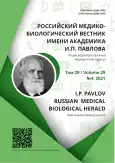Role of the GRIN1 gene polymorphism in the formation of post-traumatic epilepsy
- Authors: Gazaryan L.M.1, Selyanina N.V.1, Karakulova Y.V.1, Sosnin D.Y.1
-
Affiliations:
- Perm State Medical University named after Academician E. A. Wagner
- Issue: Vol 29, No 4 (2021)
- Pages: 449-456
- Section: Original study
- URL: https://journals.rcsi.science/pavlovj/article/view/63933
- DOI: https://doi.org/10.17816/PAVLOVJ63933
- ID: 63933
Cite item
Abstract
Introduction: NMDA receptors are involved in the pathogenesis of seizures, as it subunit is coded for by the GRIN1 gene. Different GRIN1 mutations are known in patients with different forms of epilepsy and encephalopathy. However, no data are available on the participation of the GRIN1 gene and its polymorphisms in the development of post-traumatic epilepsy (PTE).
Aim: To determine the influence of single-nucleotide rs1126442 polymorphism of GRIN1 on the risk of PTE formation.
Materials and methods: A total of 140 patients were examined, which included 69 patients with PTE and 71 patients with genetic epilepsy. All patients underwent a comprehensive examination, with evaluation of history, neurological status, electroencephalography (EEG) and neuroimaging results, and genotyping of blood samples by real-time polymerase chain reaction. The control sample for genetic examination was venous blood from 60 healthy individuals.
Results: Focal seizures with transition to bilateral and tonic–clonic seizures were predominant in the PTE group. Neuroimaging revealed dystrophic, cystic, and cystogliotic alterations and signs of external hydrocephaly. EEG recorded interictal and ictal epileptiform activity and slowing of theta waves. Genotyping by rs1126442 polymorphism of GRIN1 revealed predominance of heterozygous G/A and homozygous A/A genotypes in patients with PTE in the codominant (odds ratio (OD)=3.43; 95% confidence index (CI) 1.56–7.55; p=0.0047), dominant (OR=3.24; 95% CI 1.57–6.68; p=0.0011), and superdominant (OR=2.90; 95% CI 1.36–6.22; p=0.0048) inheritance models. The carriage of heterozygous G/A rs1126442 genotype of GRIN1 was associated with an epileptiform activity in the EEG of all patients with epilepsy (OR=2.40; 95% CI 1.11–5.20; p=0.024).
Conclusion: The carriage of heterozygous G/A genotype and homozygous A/A rs 1126442 genotype of GRIN1 in the dominant and codominant inheritance models is associated with a high risk of development of epilepsy after craniocerebral trauma. The carriage of heterozygous G/A rs 1126442 genotype of GRIN1 is associated with an epileptiform activity in EEG.
Full Text
##article.viewOnOriginalSite##About the authors
Lilit M. Gazaryan
Perm State Medical University named after Academician E. A. Wagner
Email: gazaryan_km@mail.ru
ORCID iD: 0000-0002-3970-3382
SPIN-code: 5047-3702
Russian Federation, Perm
Natalia V. Selyanina
Perm State Medical University named after Academician E. A. Wagner
Author for correspondence.
Email: nselyanina@mail.ru
ORCID iD: 0000-0002-2317-7808
SPIN-code: 9379-1027
MD, Dr. Sci. (Med.), Associate Professor
Russian Federation, PermYuliya V. Karakulova
Perm State Medical University named after Academician E. A. Wagner
Email: julia.karakulova@mail.ru
ORCID iD: 0000-0002-7536-2060
SPIN-code: 5066-6556
MD, Dr. Sci. (Med.), Professor
Russian Federation, PermDmitriy Y. Sosnin
Perm State Medical University named after Academician E. A. Wagner
Email: sosnin_dm@mail.ru
ORCID iD: 0000-0002-1232-8826
SPIN-code: 4204-6796
MD, Dr. Sci. (Med.), Associate Professor
Russian Federation, PermReferences
- Mukhin KYu. Definition and classification of epilepsy. Classification of epileptic seizures 2016. Russian Journal of Child Neurology. 2017;12(1):8–20. (In Russ). doi: 10.17650/2073-8803-2017-12-1-08-20
- Karlov VA. Epilepsiya u detey i vzroslykh zhenshchin i muzhchin. 2nd ed. Moscow: Binom; 2019. (In Russ).
- Mukhin KYu, Petrukhin AS, Mironov MB. Epilepticheskie sindromy. Diagnostika i terapiya. Moscow: Sistemnye resheniya; 2008. (In Russ).
- Kotov AS, Belova IuA. Posttraumatic epilepsy: the theory and the practice. Zhurnal Nevrologii i Psikhiatrii imeni S.S. Korsakova. 2010;110(3-2):48–51. (In Russ).
- Ioshina NN, Korsunskaya LL. Epidemiological characteristics of symptomatic epilepsy in patients with posttraumatic cystic formations of the brain. International Neurological Journal. 2014;(5):167–71. (In Russ).
- Skomorokhova EB, Dyuzhikova NA, Vaido AI. Methylation status of CPG island of GRIN1 gene in hippocampus and bone marrow of rats with different excitability of nervous system after emotional-painful stress action. Zdorov’ye ― osnova chelovecheskogo potentsiala: Problemy i puti resheniya. 2013;8(2):693–5. (In Russ).
- Begni S, Moraschi S, Bignotti S, et al. Association between the G1001C polymorphism in the GRIN1 gene promoter region and schizophrenia. Biological Psychiatry. 2003;53(7):617–9. doi: 10.1016/s0006-3223(02)01783-3
- Bespalov AY, Zvartau EE. Neuropsycopharmacology of NMDA-receptor antagonists. Saint-Petersburg: Nevsky Dialect; 2000. (In Russ).
- Collins С, Duff C, Duncan AM, et al. Hayden Mapping of the human NMDA receptor subunit (NMDAR1) and the proposed NMDA receptor glutamate-binding subunit (NMDARA1) to chromosomes 9q34.3 and chromosome 8 respectively. Genomics. 1993; 17(1):237–9. doi: 10.1006/geno.1993.1311
- Liu Y-P, Ding M, Zhang, X-C, et al. Association between polymorphisms in the GRIN1 gene 5′ regulatory region and schizophrenia in a northern Han Chinese population and haplotype effects on protein expression in vitro. BMC Medical Genetics. 2019;20(1):26. doi: 10.1186/s12881-019-0757-3
- Platzer К, Lemke JR; Adam MP, Ardinger HH, Pagon RA, et al., editors. GRIN1-Related Neurodevelopmental Disorder. Gene Reviews. 2019. [Internet]. Seattle (WA): University of Washington, Seattle; 1993–2021. Available at: https://pubmed.ncbi.nlm.nih.gov/31219694/. Accessed: 2021 March 22.
- Ohba C, Shiina M, Tohyama J, et al. GRIN1 mutations cause encephalopathy with infantile-onset epilepsy, and hyperkinetic and stereotyped movement disorders. Epilepsia. 2015;56(6):841–8. doi: 10.1111/epi.12987
- Chen W, Shieh C, Swanger SA, et al. GRIN1 mutation associated with intellectual disability alters NMDA receptor trafficking and function. Journal of Human Genetics. 2017; 62(6):589–97. doi: 10.1038/jhg.2017.19
- Gazaryan LM, Selyanina NV, Krivtsov AV, et al. Sposob prognozirovaniya individual'nogo riska razvitiya posttravmaticheskoj epilepsii. Patent RUS № 2019143381. 30.06.2020. Byul. №19. Available at: https://elibrary.ru/download/elibrary_43904230_41998727.PDF. Accessed: 2021 March 22. (In Russ).
Supplementary files






